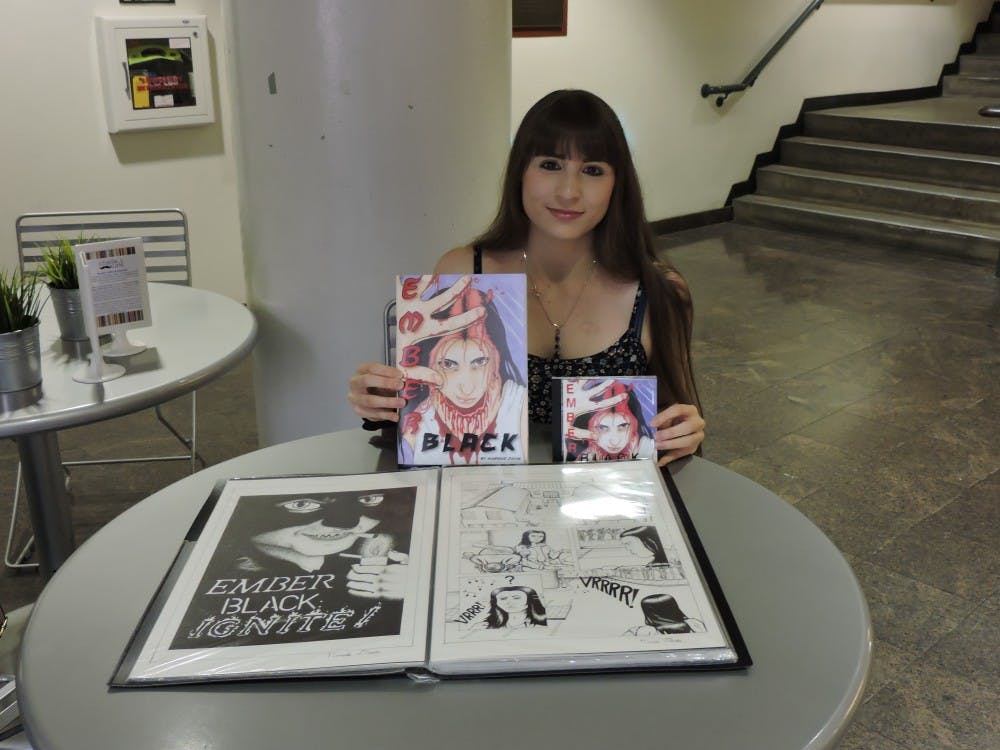Despite partial blindness in both eyes, Marieke Davis has finished a long-time aspiration during her final year at ASU: drawing and producing her own comic book, as well as an audio version for other visually impaired readers.
Davis, a drawing senior, first created the concept for Ember Black, her noir-supernatural comic over two years ago. However, production was a slow process, partially due to her visual impairment, with the audio version of the comic completed in April 2016. In August, the first copies of the print edition rolled off the press.
“Like any idea, it starts with a story you play around with over and over again,” she said. “It first started with a little bit of daydreaming of my characters, and then I went on to write a script. I went through about four or five different drafts until I was satisfied with it.”
Davis created scripts and thumbnail sketches in her free time, teaching herself as she went.
“I don’t have any formal training as a comic book artist, I’m self-taught,” she said. “There was nobody to teach me, so I educated myself through books that my mom gave me for birthday and Christmas presents.”
The story and world of Ember Black was heavily inspired by myths and legends of cultures around the world, as well as the Sandman series by Neil Gaiman, which features a number of supernatural beings.
Ember Black focuses on a teenage girl who is left for dead after the kidnapping of her younger sister and possessed by a wendigo 一 a cannibal spirit 一 named Ember.
“I’ve always been greatly inspired by mythology of all sorts, not just Greek,” Davis said. “I love legends, so I wanted to incorporate those into my story. Comics are a great way to teach people without talking down to them or being elite. I think it’s a great way to talk to people.”
Davis said her two minors in English literature and women's and gender studies, gave her the skills to create rounded and well-fleshed-out characters, especially female characters, whom she believes are underrepresented in more popular comics.
“I definitely designed all my characters, my female characters and even my male characters, to be strong,” she said. “The best way to create good characters is to make them real people, to get them as close to reality as you can.”
The first issue of the comic took over two years to complete, partially due to Davis’s visual impairment.
My comics have arrived! Thanks @asuprintlab, and Stetson Finch for helping to make "Ember Black" a reality! <3 pic.twitter.com/TS17TOnEJa
— Marieke Davis (@MariekeDavis1) September 1, 2016
“I think it’s more incredible because I’m visually impaired,” Davis said of the accomplishment. “I’m not legally blind, but legally I don’t have enough vision to drive a car.”
Her partial blindness was caused by a series of surgeries to remove a brain tumor when she was a child. Davis lost half the vision in each of her eyes, leaving her with hemi-anopsia, the loss of half the field of vision in both eyes. Comics are the easiest for her to read, as she doesn’t need to move her head to see all of the words in the panels, unlike with a regular book.
Davis’s mother, Karen Davis, narrates the story, providing context for visually-impaired readers.
“This (comic) doesn’t have a narrator,” Karen Davis said. “But some people can’t see what’s happening, so you need a narrator to describe what’s going on in the frames. I’m used to reading her textbooks into a digital recorder when there’s no audio support. To be a narrator seemed like a natural thing for me.”
The inspiration for the audio version of the story came from Jessie Newton, one of the officials from ASU’s disability resource center.
“She (Newton) inspired me to create an audio version because she’s blind, and her daughter is a visual artist,” Davis said. “She’s never even seen her daughter’s art.”
While the comic is not yet available for purchase outside of the conventions Davis has tabled at, she hopes to change before the year is out, in the form of a website dedicated to selling both versions of the story.
The comic is currently only available by contacting Davis directly, but she hopes to change before the year is out, in the form of a website dedicated to selling both versions of the story.
Davis is also in talks with the owners of the Critical Threat comic shop in Tempe to carry the comic in the spring.
Zoe Sugg, an employee at Critical Threat, confirmed an early copy of the book has been dropped off at the store, and the owners are working with Davis to put the issue out on shelves.
Davis was brought into contact with the owners of the store after winning the Herberger IDEA Showcase Audience Choice Award in April.
Davis is hoping to sell the book at the shop, but is also interested in presenting it as part of free comic book day on May 6 next year. The sale of the comics is still being worked out in the shop.
“It’s something that for a month's worth supply, for a local comic it could take much longer to sell,” Sugg said. “So it’s more complicated (to buy new issues).”
Regardless of the publishing status of her first issue, Davis is already looking ahead to future stories.
“I usually think of the beginning or the ending first, (sometimes) simultaneously,” she said. “The tough part is filling it in. But I have a pretty good idea of where (Ember) is going.”
Correction: Due to an error in reporting, changes have been made to this article on November 15th. The name of the comic has been corrected, as well as its availability, and the eye condition Davis has is called hemi-anopsia.
Reach the reporter at ckmccror@asu.edu or follow and @ckm_news on Twitter.
Like The State Press on Facebook and follow @statepress on Twitter.




